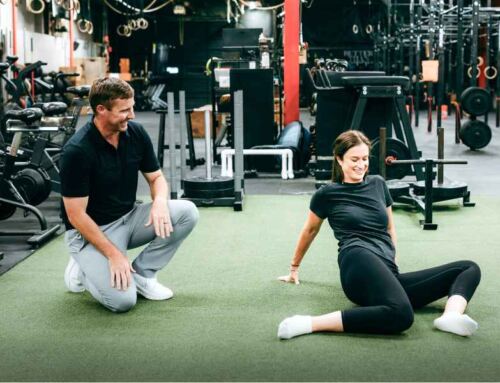Regain Your Reach: A Call to Action for Overhead Mobility
When my not-so-baby girl turned four, we celebrated her preschool milestone with a giant dollhouse. As I stood back, admiring my assembly of the finished product, I marveled at her determination to reach the tippy-top floor. She was on her toes, stretching every inch of her little body to place her Peppa Pig dolls in the attic at the very top.
And it hit me: Why can’t many of us press our hands fully overhead anymore? Is it a fear of sweaty armpits (especially in this sticky DC summer)? Or maybe it’s simpler: we stop using the motion and, inevitably, lose it.
If you’re one of those who struggles with reaching overhead, it’s time for a quick test. Go ahead, try it—I’ll wait right here with my arms fully stretched.
Now, how do we go from reaching like Amelie, to saying: “I can’t even reach overhead, and now all the dollhouse furniture is stuck on the lower floors”?
This article is for you if you say “yes” to any of the following:
- You struggle with overhead mobility.
- You want to understand how mobility and strength impact overhead movement.
- You’re ready to learn tools to address those deficits.
Sound like you? You’re in the right place. Warm up your shoulders and I’ll teach you a bit more about overhead mobility and strength.
Understanding the Problem
Overhead movement limitations generally fall into one (or more) of three categories:
- Stiffness prevents overhead position.
- Weakness prevents overhead position.
- Pain prevents overhead position.
The good news? You can address all three—simultaneously. And there is a ton of solid evidence that supports the utilization of overhead training in the presence of shoulder pain.

Myths and Misconceptions
Many of my patients come in with preconceived notions that they should not be doing any resistance work over shoulder height. I find this puzzling, as many of the major muscles of the shoulder girdle work most effectively at progressive levels of shoulder elevation.
For instance, the Serratus Anterior and Lower Trapezius muscles demonstrate improvements in activation with progressive levels of arm elevation (2-4). Additionally, it’s been established that the Overhead Press facilitates increased upward rotation and posterior tilt of the scapula, and reduced scapular internal rotation—all of these motions facilitate better reaching overhead (1).
But what happens if you can’t get your arms fully overhead? Don’t worry. You can still train effectively with your current range of motion. Numerous studies have shown the value of “partial range of motion” training, including a “training overflow” of 30 degrees beyond the training range (5-6).
Keep your eye on the prize and, if it helps, think of stretching towards the attic of that dollhouse—step by step.
Movement Progressions: Reclaiming Your Overhead Mobility
Building a strong overhead movement won’t happen overnight. It takes countless reps of purposeful, specific movements. If you’ve read my earlier posts (like Step Up Your Ground Game), you’ll recognize this principle: mobility comes first. This principle and another can serve as 2 solid rules of thumb when building overhead mobility and strength. They are:
Principle of Movement #1
Mobility comes first! You cannot be strong in a position if you are too stiff to get there in the first place.
Principle of Movement #2
Build strength and resilience in the range you possess. Start overhead training within your good quality range of motion.
With these two principles in mind, here are some movements and exercises to help you progress in improving your overhead mobility and overhead strength.
1. Towel Pull-Apart Drill
This is a great starting point for those in the early stages of overhead mobility. With assistance, you can gently introduce your shoulders to overhead movement.
Dosage: 20-30 second sets, progressing to 5-minute sets as your tolerance improves (7).
2. Supine Pull-Over
This exercise is a helpful way to practice overhead reaching while lying down, reducing the load on the shoulders.
Dosage: Start with 20-30 second sets and gradually progress to 5-minute sets as your tolerance improves (7).
3. Sidelying Shoulder Press
This movement begins to incorporate strength while limiting the load by keeping you in a side-lying position, which offers better control.
Dosage: 12-20 reps, adjusting weight and reps as you improve (like a high rep strengthening exercise).
4. Pull-Up Hold
If you haven’t hung from a bar in a while, this exercise will gently stretch your shoulder girdle while working on strength. Start by keeping your feet on the ground, then progress to a full hang (and achieve Amelie-status)!.
Dosage: Begin with small holds (1-3 seconds), gradually increasing to 20-30 seconds.

5. Lat Pull-Down
Once you’ve built some initial strength and mobility, this exercise helps refine overhead mobility while simultaneously building back strength.
Dosage: 12-20 reps. Treat this as a high repetition exercise and build weight over time.
6. Incline Press
The incline press targets the shoulders and upper chest while easing you into overhead pressing by working at a slightly reduced angle. It’s an effective way to build strength and mobility before progressing to full overhead movements.
Dosage: 12-20 reps. Gradually progress in weight and reduce reps after 1 month.
Side Note: Addressing Pain
Pain is a hairy, complex beast that deserves its own blog post. While steady progression in these movements may reduce your pain you may need more guidance. Luckily, physical therapists thrive in the face of pain. If you have questions or concerns about pain limiting pressing overhead that cannot be addressed with these videos, schedule a consultation with me and my friends at MovementX!
Your Overhead Movement Prescription
Restoring overhead mobility takes consistent, daily effort—but it doesn’t have to be complicated. By incorporating simple, regular practices into your routine, you can gradually improve your range of motion and reclaim your ability to reach overhead with ease. Here are some quick, effective strategies to integrate into your daily life to maintain and build mobility.
- Follow the 20/20 Rule: Every 20 minutes, step away from your desk, raise your arms overhead for 20 seconds, and check your antiperspirant.
- Brush your teeth, brush your body: Spend 3-5 minutes every morning and night stretching and exploring your overhead position.
- Assess, don’t guess: Use the Wall Shoulder Flexion Test regularly to track your progress and determine which movements offer the most improvement.
Take Home Message
Overhead mobility is essential not just for reaching high shelves or dollhouse attics, but for maintaining full function in your daily life. Whether stiffness, weakness, or pain is holding you back, the good news is that all three can be improved with consistent, targeted effort.
Start by incorporating mobility exercises, like the pull-up hold and towel pull-apart drill, and gradually progress to more challenging movements like the incline press. While progress takes time, regular practice will help you regain your ability to reach overhead with confidence.
Remember, mobility is an ongoing effort. Use the “20/20 Rule” throughout the day, and dedicate a few minutes each morning and evening to overhead movements. Track your improvements with the Wall Shoulder Flexion Test to see which exercises work best for you.
If pain or difficulty persists, working with a physical therapist can help you overcome barriers and guide your progress safely. Don’t hesitate to book an appointment with a MovementX physical therapist for personalized guidance and support.
With consistent effort and professional help when needed, you’ll soon reclaim your reach and fill those top shelves with ease!
References
- Ichihashi N, Ibuki S, Otsuka N, Takashima S, Matsumura A.Kinematic characteristics of the scapula and clavicle during military press exercise and shoulder flexion. J Shoulder Elbow Surg (2014) 23, 649-657
- Bäcker, H. C., Galle, S. E., Maniglio, M., & Rosenwasser, M. P. (2018). Biomechanics of posterior shoulder instability – current knowledge and literature review. World Journal of Orthopedics, 9(11), 245-254.
- Bdaiwi, A. H., Mackenzie, T. A., Herrington, L., Horsley, I., & Cools, A. M. (2015). Acromiohumeral Distance During Neuromuscular Electrical Stimulation of the Lower Trapezius and Serratus Anterior Muscles in Healthy Participants. Journal of Athletic Training, 50(7), 713–718.
- Ekstrom, R., Donatelli, R. and Soderberg, G., 2003. Surface Electromyographic Analysis of Exercises for the Trapezius and Serratus Anterior Muscles. Journal of Orthopaedic & Sports Physical Therapy, 33(5), pp.247-258.
- George Davies – A Master Clinicians Approach to Advanced Concepts in Examination and Treatment of the Shoulder Complex – 2016
- Clark, RA, et al. The influence of variable ROM training on neuromuscular performance and control of external loads. JCSR. 25:704-711, 2011.
- The role of anterior deltoid reeducation in patients with massive irreparable degenerative rotator cuff tears Ofer Levy, MD, MCh(Orth), Hannan Mullett, FRCS(TR & Orth), Sarah Roberts, Bsc(Hons), Bed(Hons), MCSP, and Stephen Copeland, FRCS, Reading, United Kingdom – J Shoulder Elbow Surg 2008;17:863-870.
About the Author
Dr. Dan Alcorn is a physical therapist with MovementX in Northern Virginia. He is a Board-Certified Specialist in Orthopedic Physical Therapy and is also fellowship-trained in the care for upper extremity athletes. Dan Alcorn treats patients at Patriot CrossFit in Arlington, VA, and has a strong passion for improving people’s confidence through healthier movement, lifestyle choices, and longevity.








